Forearm Pain When Curling: Causes And Solutions
Author:
Reviewed by:
(21 years of Oly Lifting experience)
Unlock your full potential by engaging with our experts and community! Have questions about your fitness journey or looking for expert advice on weightlifting techniques? Don’t hesitate — leave a comment below and David Sasha Schulz will provide a personalized answer and insights to help you reach your goals.
Torokhtiy is reader-supported. Some links are affiliate links, and we may earn a commission at no extra cost to you. See our disclosure page for details.
The bicep curl is one of the most effective and versatile arm exercises. It can be done standing or seated, with a barbell, cable machine, resistance band, or pair of dumbbells or kettlebells. A common problem exercisers report is forearm pain when curling.
All variations of the said movement primarily work biceps while some get more help from shoulder and arm muscles than others, according to this ACE Biceps study by Scott Young. However – forearm pain during these exercises is not normal. Let’s identify possible reasons and their remedies.
Why are you feeling forearm pain when curling? There are many reasons to get forearm pain from bicep curls including pre- existing injury, overuse/overtraining, and inadequate warm-up. To prevent this problem, bring expert-vetted progression and periodization to your bicep training. Consult a doctor if your forearms hurt during curls excessively.
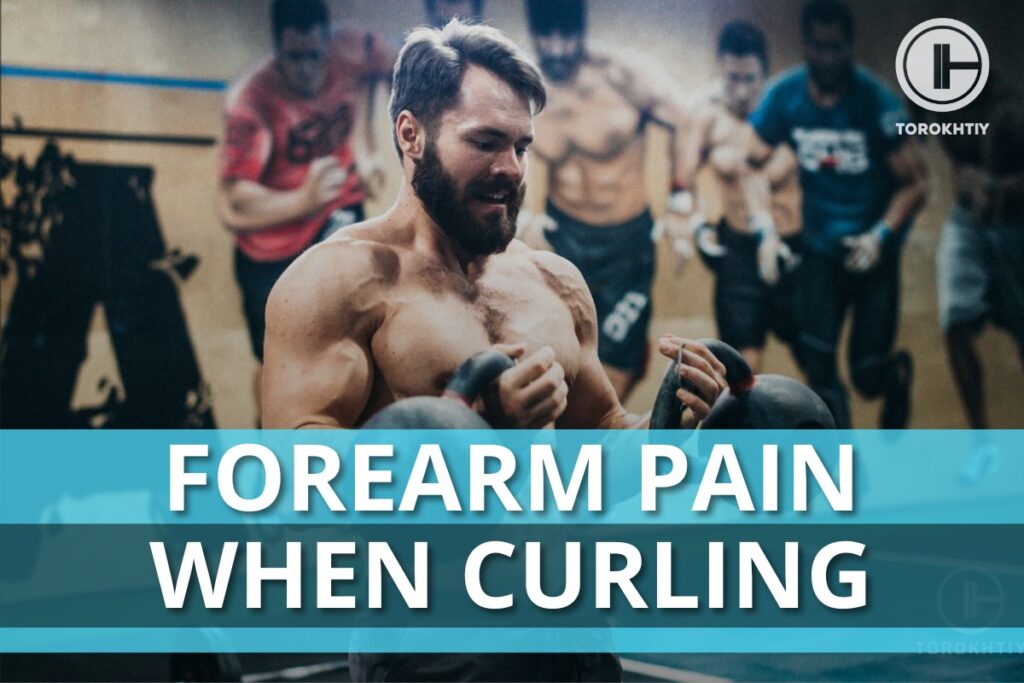
Introduction to Forearm Pain from Bicep Curls
The bicep, or biceps brachii, is a two-headed superficial muscle perched on the front of the upper arm between the shoulder and the elbow. It is responsible for elbow flexion (bending) and forearm supination (palm facing up).
The other major, but lesser known, elbow flexor lies deep to the the bicep and is called brachialis. The forearm lies between the elbow and the wrist. There are many muscles in this part of your arm, but they mainly control wrist and finger movements.
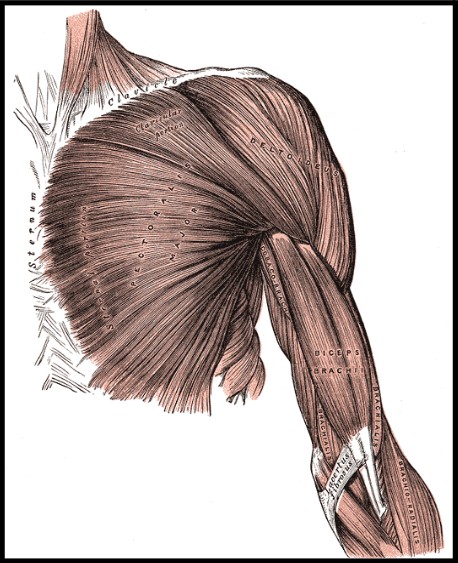

The bicep curl is a single-joint isolation movement. It involves concentric and eccentric contractions of the biceps brachii and brachialis. The muscles in the forearms act isometrically (not lengthening or shortening) to grip the weight.
Feeling stiff and pumped in the forearms for some time during and after the exercise is normal. The presence of pain, however, may indicate a more significant issue, which we’ll try to uncover in the next section. You may have developed tendonitis with repetitive motion, manifesting as a dull ache or burning in the forearm or elbow.
Tips From the Champ
In some cases, forearm pain may arise due to more severe problems, like infection, nerve entrapment, or arthritis. The best course of action is to seek expert-supervised diagnosis and treatment.
Olympic Weightlifting Champion
What Causes Forearm Pain when Curling?
Now you know your forearms hurt after curls likely due to tendonitis. It’s characterized by inflammation and irritation of the affected tendon (likely a wrist flexor). But what is it that you’re doing wrong in the first place?
1. Overtraining
Your body needs sufficient breaks to rest, revitalize, and grow. Research has proven multiple benefits of training to failure, but it’s not free from side effects. Performing the failure technique too often, or training too much in general can lead to overtraining and overuse injuries. You can have too much of a good thing!
When we do bicep curls, the involved muscles are at risk of overtraining, even synergists like forearms. The periodization and progression of your training must be planned according to your current fitness level.
2. Technique
Some gym bros may encourage what many people call ‘ego-lifting’. This is when you use too much weight for proper technique, or do more repetitions beyond technical failure. You will end up using your legs, back to swing the bar up, which is not only more fatiguing overall, but actually more likely to cause injury and less effective at actually training the biceps.
3. Posture
The slumped posture is another form issue. Due to the prevalent sedentary lifestyle, people are used to keeping their shoulders rounded and rolled forward. An association exists between rounded shoulders, forward head, and hyperkyphosis or hunched back.
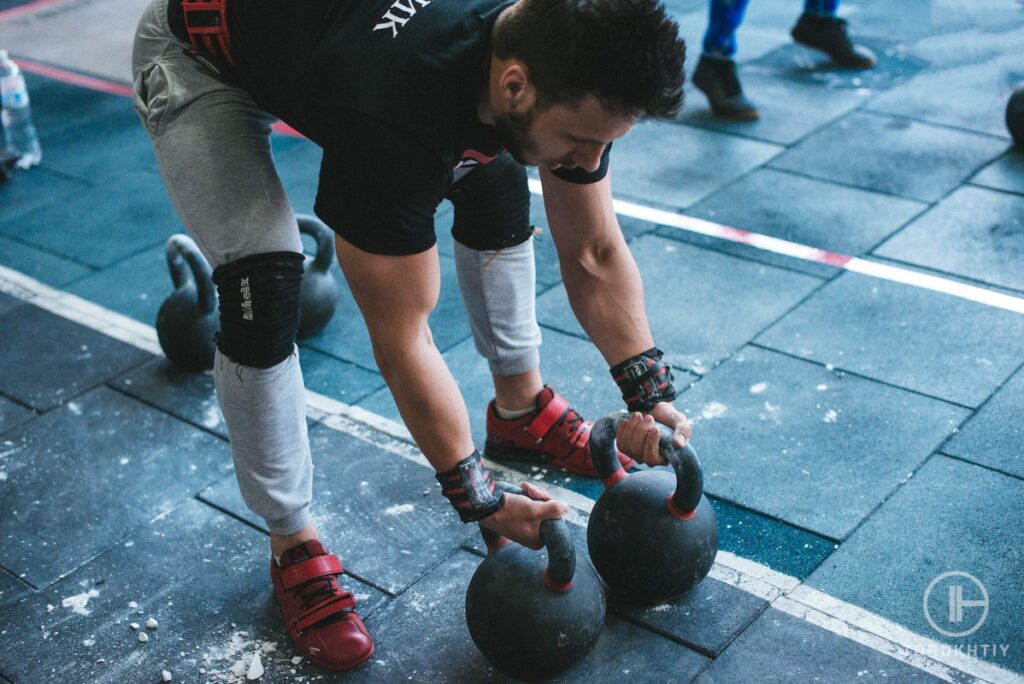
This posture could possibly be forcing you to use a technique that causes inner forearm pain from bicep curls. This posture will also limit the range of motion of the curl, which will decrease the effectiveness for muscle growth. Stand or sit tall with your hips, elbows, shoulders, and neck stacked in a line.
4. Insufficient warmup
If you have forearms hurting when curling, you can try stretching your forearms prior to curling. Regular warm-ups and percussion therapy can also help. The forearms have several muscles and nerves wrapped in thick fascia coverings. They make a formidable team, but it doesn’t take much to pull or pinch one component.
| Problem | Fix |
|---|---|
| You’re overtraining your arms. | Decrease training intensity and volume. Consult a coach or find a program moving forward. |
| You are ego lifting | Decrease the weight and use controlled tempo with full range of motion. |
| You’re rounding your shoulders. | Stand/sit up straight. Do stretches to open up your chest and reduce slouching if needed. |
| You’re not warming up your forearms. | Tight muscles are more prone to strains and injuries. Follow warm-up and recovery protocols. |
How to Do Curling Without Hurting Your Forearms?
Do you want to avoid obstacles between you and massive Popeye-like arms? Prevention is the best cure! Don’t wait to make changes until your forearms hurt during curls. Instead, take proactive steps like these tried-and-tested ones.
1. Maintain proper form
In order to get the most out of your training in the gym with minimal risk, having proper technique is pivotal. Curling is not a swinging or heaving motion that should stress your hips, back or shoulders. Many people lift with momentum, and let the weight drop quickly from the top. Lower the weight under control, or even slowly, then lift it up more quickly. The eccentric phase is equally important as, if not more important than the concentric phase.
- Grab the barbell, as it hangs touching your abdomen/ thighs with your palms facing forward.
- Raise the bar all the way to your shoulder (or near it) by bending the elbow. See that neither your shoulders nor your wrists initiate the movement.
- Then, control the lowering phase until the arms are fully extended.
2. Consider a low-load scheme
There is an earnest desire to curl 25 lbs today and 50 lbs the very next day. Be patient! Start with a load that is suitable for your fitness level. You should be able to do at least ten repetitions. You can progress after a week. But progression happens in two ways: either you lift more weight or the same weight for additional reps.
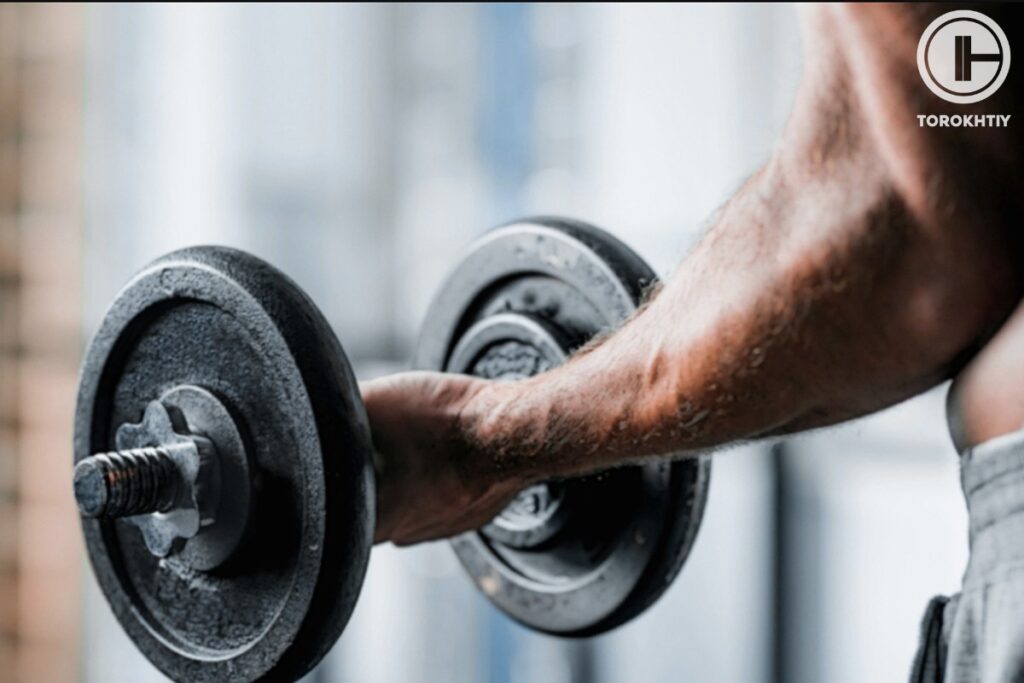
Trying to increase the weight too quickly will likely change your technique (for the worse) and may be the reason for the issue. Research shows that low-load and high-load resistance training evoke similar hypertrophy when trained to momentary muscular failure.
3. Try using wrist wraps/straps and EZ bars
You can look up to a few accessories to give your wrists a break. Wrist wraps are long cotton-elastic straps purported to secure and stabilize your wrists. Straps are usually made from nylon or canvas and wrap around the bar to decrease the demand on the gripping muscles.
Another equipment to add to your arsenal is the EZ Curl Bar. Unlike straight barbells, its multi-angled construction enables a more natural and comfortable (semi-supinated) grip. Studies comparing muscle activity have shown that EZ bars are superior to dumbbells and comparable to straight bars.
4. Do warm-ups and stretches
Getting adequate warm-ups enhances your exercise performance. It heightens blood flow, body temperature, and muscle flexibility to tackle the upcoming challenge. Start with lighter curls to warm your biceps, but lower arms must not be regularly overlooked.
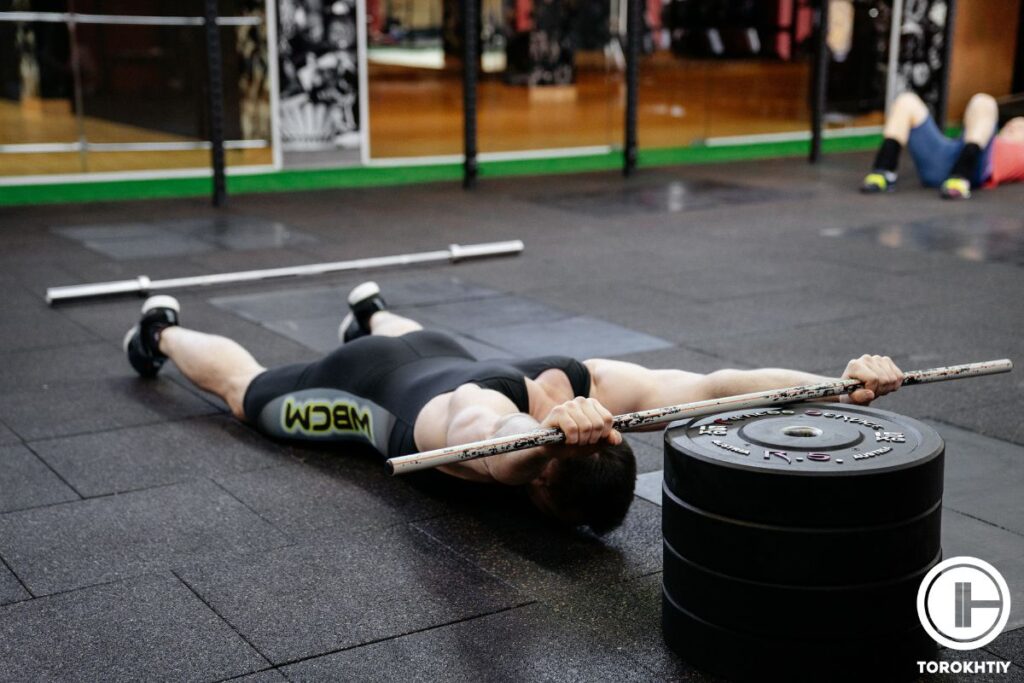
Stretch your forearms by bending the wrist backward and forward several times. Don’t forget to incorporate shoulder mobility and chest opening exercises if your posture needs work.
Tips From the Champ
Allow a healthy recovery period. Back and biceps training is mostly paired on the same day. What you may not realize, however, is that your forearms and/or wrists are taxed significantly during some lower body and pushing exercises. The same is true if you do a lot of computer work or manual labor.
Olympic Weightlifting Champion
How to Treat Forearm Pain From Bicep Curls?
Why does my forearm hurt when I curl? Well, your quest brought you to this article, and now you know what mistakes you made. This will serve you well whenever you resume training. For now, follow these cessation and recovery guidelines to decrease the pain and fully regain forearm strength.
According to the American Academy of Orthopedic Surgeons, the four-step RICE pain management method is usually very effective. It stands for Rest, Ice, Compression, and Elevation. You can observe it yourself at home or under the watch of a healthcare provider. You may be advised to take over-the-counter NSAID medication, massage, or a rehab program along with the RICE protocol.
Follow us!

Free!
Get a 2-week Weightlifting Program as a bonus for the subscription to kickstart your training plan!

Free!
- Rest: You must be familiar with the ‘no pain, no gain’ philosophy. However, the pain of muscle damage and subsequent growth differs from that of an injury. Loading the injured area excessively only exacerbates the situation. Once you’ve spotted that your forearms hurt during curls due to tendonitis, cease the curling activity and rest for 24 to 48 hours.
- Ice: While resting the affected part, apply an ice pack over and over. It is well-known for reducing pain and swelling. The CDC recommends wrapping the ice in an absorbent towel or cloth to prevent frostbites. Your doctor may suggest switching to heat therapy, which is beneficial for easing stiffness. Look for more info on when to chill and when to heat.
- Compression & Elevation: Compressing the area with steady pressure can help decrease the swelling. The best way is to wrap an elastic medical bandage – not loose or too tight! Lastly, it’s recommended that you should elevate the injured area above the heart level. It can be easily done by placing pillows under your arms when falling asleep.
FAQ
Is Curling Good for Forearms?
Regular curling effectively works the biceps and brachialis muscles but only has isometric loading of the forearm muscles. Other variations that better engage target muscles should be preferred if you want to build bigger forearms.
David Barr (2021) lists the following curling exercises for forearms:
- Pronated Barbell Curls
- Cable/Dumbbell Hammer Curls
- Crush Curls with a Medicine Ball
- Behind-the-Back Wrist Curls
- Dumb/Kettlebell Handshake Curls
How Do You Prevent Tendonitis When Curling?
Get adequate warm-up and rest to prevent tendonitis in your forearm, elbow, bicep, and rotator cuff. Also, don’t lift more than your current fitness level warrants.
Should You Twist Your Arm When Curling?
You can try twist curls, a variation where you twist your arm before lowering the weight. It rounds out both bicep functions: flexing and supinating the forearm.
Conclusion
Forearm pain when curling is a common and easily treatable condition, especially among novice lifters. Follow a proper progression or program and use good technique. Once you master the basics, even the lighter load will isolate and work your biceps better.
Keep in mind that self-care can take you to an extent. If the pain is stubborn, get it diagnosed and treated by professionals. Do tell us if you have ever faced an injury while working out. How did you react and rehabilitate? We’ll wait to hear your stories and lessons in the comment section.
Also Read:
- Elbow Pain From Push Ups: Causes & Prevention
- Elbow Pain from Pull Ups: Reasons and Solutions
- Elbow Pain From Curls: Causes, Treatments and Tips
- Low Hang Snatch: Technique, Benefits & Common Mistakes
Referenses:
- Cleveland Clinic, (2020), “Here’s How to Choose Between Using Ice or Heat for Pain,” https://health.clevelandclinic.org/should-you-use-ice-or-heat-for-pain-infographic [accessed February 07, 2023]
- David Barr, Massive, Muscular Arms: Scientifically Proven Strategies for Bigger Biceps, Triceps, and Forearms, (Human Kinetics, First Edition, 2021), 161-171
- Deepika Singla, Zubia Veqar, “Association Between Forward Head, Rounded Shoulders, and Increased Thoracic Kyphosis: A Review of the Literature,” J Chiropr Med 16, no. 3 (2017):220-229
- Fradkin Andrea J., Zazryn Tsharni R., Smoliga James M., “Effects of Warming-up on Physical Performance: A Systematic Review With Meta-analysis,” J Strength Cond Res 24, no. 1 (2010):140-148
- Giuseppe Marcolin, Fausto Antonio Panizzolo, Nicola Petrone, Tatiana Moro, Davide Grigoletto, Davide Piccolo, Antonio Paoli, “Differences in electromyographic activity of biceps brachii and brachioradialis while performing three variants of curl,” PeerJ 6 (2018):e5165
- Jeffrey M. Willardson, “The application of training to failure in periodized multiple-set resistance exercise programs,” J Strength Cond Res 21, no. 2 (2007):628-631
- Jozo Grgic, “The Effects of Low-Load Vs. High-Load Resistance Training on Muscle Fiber Hypertrophy: A Meta-Analysis,” J Hum Kinet 74 (2020):51-58
- National Academy of Sports Medicine (NASM), NASM Essentials of Corrective Exercise Training: First Edition Revised, ( Jones & Bartlett Learning; 1st edition, 2013), 360
- Paweł Pakosz, Mariusz Konieczny, Przemysław Domaszewski, Tomasz Dybek, Mariusz Gnoiński, Elżbieta Skorupska, “Comparison of concentric and eccentric resistance training in terms of changes in the muscle contractile properties,” Journal of Electromyography and Kinesiology 73 (2023):102824
- Scott Young, John P. Porcari, Clayton Camic, Attila Kovacs, Carl Foster, (2014), “ACE Study Reveals Best Biceps Exercises” https://www.acefitness.org/continuing-education/prosource/august-2014/4933/ace-study-reveals-best-biceps-exercises/ [accessed February 05, 2023]
- Mary K. Mulcahey, (2020), “Sprains, Strains, and Other Soft-Tissue Injuries” https://orthoinfo.aaos.org/en/diseases–conditions/sprains-strains-and-other-soft-tissue-injuries/ [accessed February 07, 2023]
Why Trust Us?
With over 20 years in Olympic weightlifting, strength training, nutrition coaching, and general fitness our team does its best to provide the audience with ultimate support and meet the needs and requirements of advanced athletes and professional lifters, as well as people who strive to open new opportunities and develop their physical capabilities with us.
By trusting the recommendations of our certified experts in coaching, nutrition, and sports training programming, as well as scientific consultants, and physiotherapists, we provide you with thorough, well-considered, and scientifically proven content. All the information given in the articles concerning workout programming, separate exercises, and athletic performance, in general, is based on verified data.
The product testing process is described in more detail here.
Author: David Sasha Schulz
Doctor of Chiropractic, BSc Human Biology, CSCS
Strength coach (CSCS) – 10 years
Sasha is a Chiropractor and Kinesiologist practicing in Kelowna, BC, Canada. He has been practicing Chiropractic since 2019, integrating manual therapy, strength training and programming principles, and nutritional strategies to get his patients optimal results. He currently scratches the competitive itch in fitness, and the occasional endurance race, and plays golf and snowboards for fun. He has an interest in all strength and fitness-related sports.
Reviewed by: Oleksiy Torokhtiy
Olympic Weightlifting Champion, PhD in Sport Science
Best Results: Snatch – 200 kg,
C&J – 240 kg
Oleksiy Torokhtiy is a professional athlete boasting 20 years of experience in Olympic weightlifting. With multiple European and World titles under his belt, he has showcased his prowess in two Olympic Games (Beijing 2008 and London 2012). Upon concluding his illustrious career, Oleksiy dedicated himself to coaching. By 2022, he had conducted over 200 weightlifting seminars worldwide. He is the visionary behind an international sportswear and accessories brand known for its motto, “Warm Body Cold Mind.” Additionally, he is an esteemed author and the creator of a series of training programs and eBooks.





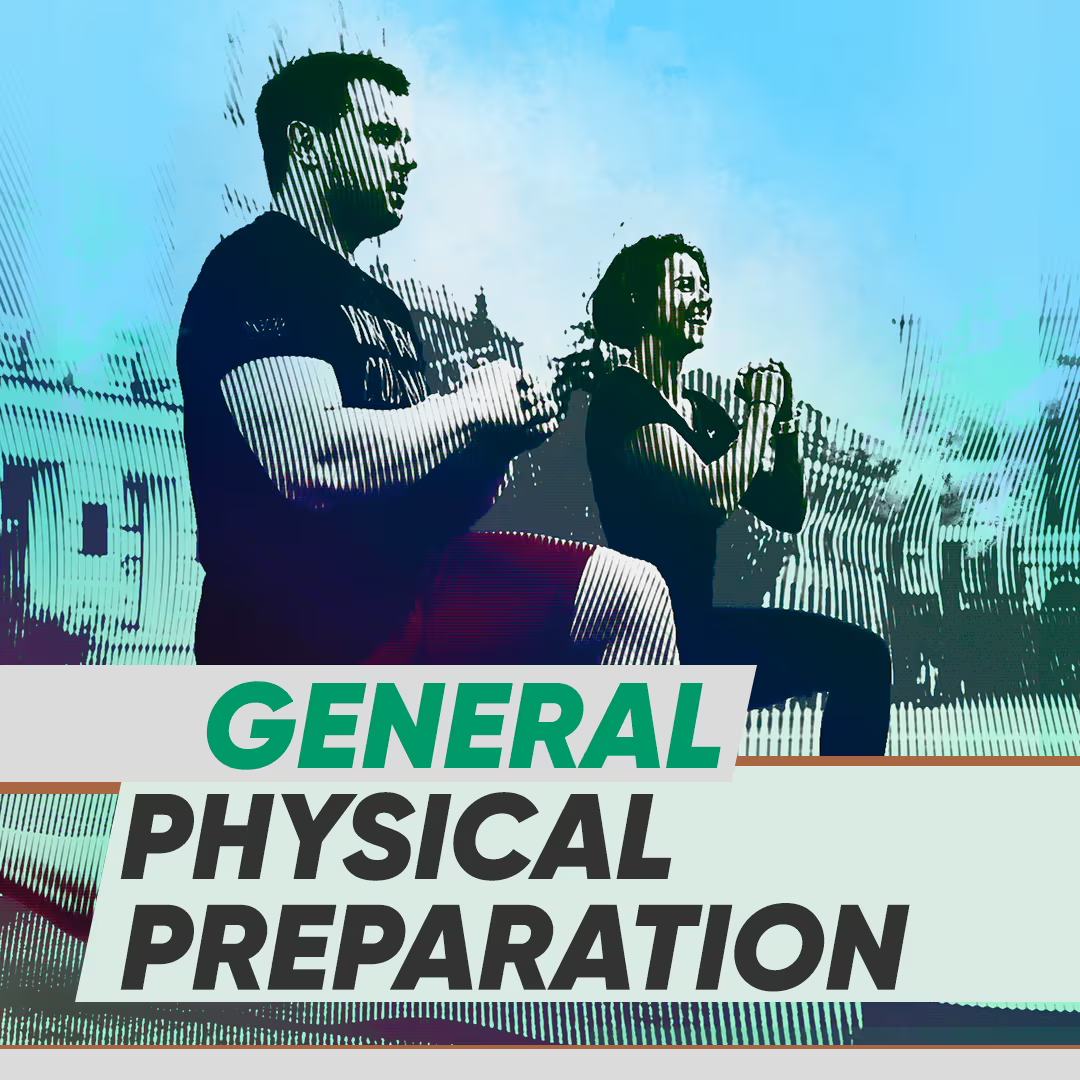
Still have questions after reading our article? Unlock your full potential by engaging with our experts and community! Don’t hesitate — leave a comment below and David Sasha Schulz will provide a personalized answer and insights to help you reach your goals.